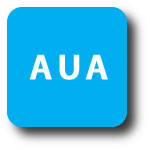ORLANDO, FL USA (UroToday.com) - Ureteroscopy (URS) has emerged as the first-line treatment for distal ureteral calculi, but optimal management for proximal ureteral stones still remains unclear.
The study group designed a prospective, multi-institutional study of outcomes for ureteroscopic management of proximal ureteral stones < 2 cm to determine the benchmark efficacy of this approach.
 Patients with proximal ureteral calculi < 2 cm were prospectively identified, and patients with concomitant ipsilateral renal calculi or prior ureteral stenting were excluded. Flexible ureteroscopy, Holmium laser lithotripsy, and ureteral stent placement was performed. Ureteral access sheath use, laser settings, and other details of peri- and post-operative management were based on individual surgeon preference. Stone clearance was determined by renal ultrasound and KUB results at 4–6 weeks postoperatively.
Patients with proximal ureteral calculi < 2 cm were prospectively identified, and patients with concomitant ipsilateral renal calculi or prior ureteral stenting were excluded. Flexible ureteroscopy, Holmium laser lithotripsy, and ureteral stent placement was performed. Ureteral access sheath use, laser settings, and other details of peri- and post-operative management were based on individual surgeon preference. Stone clearance was determined by renal ultrasound and KUB results at 4–6 weeks postoperatively.
Of 69 patients, 42 (61%) were male and 27 (39%) were female. Mean age was 48.6 years. ASA score was 1 in 11 (16%), 2 in 40 (58%), 3 in 16 (23%), and 4 in 2 (3%). Mean BMI was 31.6kg/m2. Mean stone size was 7.4mm (5-15). Mean surgical time was 60.3 minutes (15-148 min). Access sheaths were utilized in 46 (67%) patients. Intraoperative complications occurred in 2 patients (2.8%). Postoperative complications occurred in 6 (8.7%), including UTI (3), urinary retention (2), flash pulmonary edema (1). The stone-free rate was 95%.
The research group showed that flexible ureteroscopy is associated with excellent clinical outcomes when applied to proximal ureteral stones < 2 cm, comparing favorably with SWL. These data may serve as benchmarks for future studies, and inform the debate regarding optimal treatment of stone-forming patients.
Presented by Elias Hyams, MD at the American Urological Association (AUA) Annual Meeting - May 16 - 21, 2014 - Orlando, Florida USA
Lebanon, NH USA
Written by Achim Lusch, MD, University of California (Irvine), and medical writer for UroToday.com

